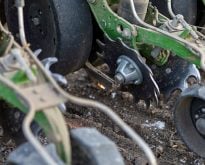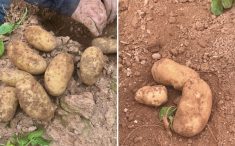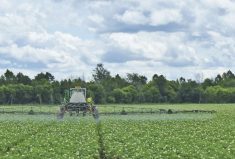Soybeans, soybeans — and more soybeans. That’s the forecast from most corners of the agri-food industry, whether it’s based in Western Canada or in the East. Soybean production in Canada was big in 2014 and it’s on a path to grow even bigger in 2015.
At the same time, that growth will come at a cost for many growers, particularly in Ontario, where there are likely to be more second- and third-year soybeans. One forecast says at least one-third of the acres planted in this province will be in second-year fields.
Read Also

Will investments in defence benefit Canadian agriculture?
A bump in Canada’s NATO spending commitments could lead to infrastructure investments that would benefit rural areas
Yet there are also some hopeful scenarios to be seen as the growing season begins to unfold. Unlike 2001, 1993 or even 1988, weather extremes have popped in the past five years, yet crops have fared quite well, with better yields than expected. It’s a testament to two developments: that timely rains or warm spells really can make up for an otherwise poor season, and the public and private plant breeders are doing an excellent job incorporating the right germplasm to handle stress.
Even so, opting out of standard rotations puts that progress at risk. Although some in the industry are forecasting three million acres of soybeans for Ontario, Pat Lynch, an independent agronomist from Stratford, Ont., believes this figure could climb higher — maybe to 3.25 million.
A lot will depend on the influence of other cropping factors. Corn’s pricing below the US$4 mark at the end of 2014 together with poor winter wheat plantings are likely to drive more acres into soybeans for the year ahead. Even the federal government is projecting a production increase of 11 per cent across the country, with domestic crush to rise by four per cent and exports to jump more than 20 per cent.
Against that backdrop, says Lynch, it isn’t just the continuous nature of soybeans in the rotation, it’s the lack of a break between soybean crops. Some areas in certain counties have seen three years of soybeans out of the past four, even when corn prices were good.
“Some soils are just too heavy to grow much of a corn crop,” says Lynch, who happens to be the one forecasting at least a third of Ontario soybean acres will be second- or third-year fields. “The only thing that had changed was soybean prices being higher, so returns were better the last three years.”
Soybean prices are likely to remain better than corn for the time being, and more growers are trying other practices to help mitigate the effects of continuous soybeans, adding applications of certain fertilizers, planting earlier and ensuring they have the best varieties to suit their soils and farming practices.
Among the bigger concerns with continuous soybeans is the impact from diseases. (Read more about the situation on soybean diseases for 2015 on page 14.) White mould has become a particular problem in the past two years in southern Ontario, the incidence of sudden death syndrome (SDS) is also on the rise, and soybean cyst nematode (SCN) continues as one of the more consistent yield robbers across the province. With that in mind, says Lynch, growers really need to be more vigilant with certain management practices.

“The weakest part of a soybean plant is below ground, and if growers could see how much disease is below ground, they’d be appalled,” says Lynch. That’s why something as simple as switching varieties can help by providing different genetic control of different diseases.
Lynch also cites use of a seed treatment, which he calls “a must.” For white mould control, some suggest decreasing population and widening the row widths, but Lynch isn’t convinced either measure is necessarily a benefit.
“In my experience, wide-row soybeans are just as prone where white mould is severe,” says Lynch, adding that wider rows on continuous soybeans tend to yield lower. “There is also no doubt that increasing seed rate is a good strategy. More years of beans means more diseases and more seedling death.”
Fertilizer considerations
The big shift that Lynch believes we’ll see in 2015 is in crop fertilization. There’s been considerable discussion in Ontario and the U.S. dealing with fertilizing soybeans. U.S. farm publications have featured grower testimonials on the practice, some from farmers with more than five different in-season treatments. As well, there have been urgent reminders from dealers and retailers, calling attention to the fact that in Ontario, soils in general are testing poorly, particularly on phosphorus (P) and potassium (K).
“More farmers will look at fertilizer but, unfortunately, too few will look at the basics of pH, P and K,” cautions Lynch. “They’ll be spending time and money on ‘silver bullets’ that are foliar-applied. It’s good to look at some of these products but it must be in a co-ordinated, well-thought-out fashion after you have the basics of N, P, K, magnesium and manganese addressed.”
Weed control
Robert Moloney shares many of Lynch’s observations, particularly “breaking the cycle” that continuous soybeans doesn’t allow. Corn and soybeans do a tremendous service in rebooting the soils and adding an element of diversity that doesn’t allow disease, pest and weed cycles to become entrenched.
“Corn, with that one-year break in there, pretty much resets everything, so it’s not a big deal where it resets the yield bar,” says Moloney, a certified crop adviser with Boyd’s Farm Supply in Fordwich, Ont., north of Listowel. “With soybeans, you really do need that two-year break away from the crop in order to reset the bar back to its full potential with corn and soybeans,” says Moloney. “That’s not really a rotation; growers are just alternating crops.”
Another problem that’s going to really challenge growers this year will be weed management. Moloney has seen more eastern black nightshade in his area, along with more pigweed. The herbicide resistance angle has not been a huge challenge in midwestern Ontario, says Moloney, but he’s seeing signs of Group 2 resistance showing up with greater frequency. And still another issue that will further confound the weed management situation is that of volunteer corn: there’s more of it and it’s getting harder to control.
“We had a lot this year, we sprayed a lot this year, and we should have sprayed a whole lot more, but we ran out of time and product, and it became a real challenge,” says Moloney.
Moloney also notes that one of the successes of late 2014 was communicating to growers that with more continuous soybeans, cutting back on tillage might be a means of reducing disease potential. But like Lynch, he sees the whole fertility and nutrient situation continuing, especially where many growers still believe soybeans to be the crop that doesn’t need any fertilizer, a notion that’s both stereotypical and inaccurate.
“Some still have a little bit of an attitude that you don’t need to fertilize soybeans, but with potash in particular, because we’re pulling 50- and 60-bushel soybeans consistently, so we’re taking out a lot more potash, most of the time,” says Moloney. He’s even boosted his potash recommendations in the past couple of years. “We’re starting to get through that cycle where the soil tests are at best holding even and, in a lot of cases, are starting to slip on potash, just because we’re taking into account the yield and how much potash we’re taking out.”
Considerable jump in yields
For Horst Bohner, a larger soybean crop in the province carries some defined risks, including diseases, weeds and the overall impact on rotations. The state of the winter wheat crop has been thrown into uncertainty, and corn’s late harvest and high drying charges through last fall have highlighted its struggles. That’s why the historical numbers on soybeans are so gratifying to Bohner, the soybean specialist for the Ontario Ministry of Agriculture, Food and Rural Affairs.
In 1984, the provincial average yield for soybeans was 34 bushels per acre, and for the first time in the history of agriculture in Ontario, there were a million acres of soybeans. In 1997, the province eclipsed two million acres for the first time, with a five-year average of 39 bushels per acre.
“Now the five-year average at 3.05 million acres is 46.5 bushels per acre,” notes Bohner. “If you look at it that way, we’ve made tremendous progress.”
Yet he concedes that the historical record doesn’t help the short-term prospects for growers, especially those who are facing second- and third-year soybean crops and what that can mean particularly on the disease front.
“I do think that we need to stress that the yield expectations have to be lower in second- or, especially, in third-year soybeans,” says Bohner. “You just can’t expect to get what you would if it was after corn — it’s pretty hard to pull off a 55-bushel field in second-year soybeans.”
In a stressful year, he adds, consecutive years of soybeans fare much worse than crops where rotations are maintained. In stress-free years, where there’s adequate moisture, sufficient heat, low pest populations, good weed management and adequate fertility, second-year beans will do quite well. But with the introduction of any moderate to severe stresses such as excessive dryness, high aphid counts or white mould in a wet year, those second- and third-year soybean fields will be the first to show the effects.
To mitigate those second- and third-year risks, Bohner preaches the fundamentals. Reducing tillage is one practice which he believes can have an impact, and Bohner believes that dropping the seeding rate will create more air through the canopy, reducing diseases.
“There’s no question that lower plant stands have an impact on the incidence and severity of white mould, so the issue is around row width also, and there’s some evidence that wider rows play a role in this,” says Bohner. “But the bigger factor is the number of plants established per acre.”
Bohner also echoes Moloney’s concerns about weed control issues. Again, in a second- and third-year soybean scenario, growers are getting into that established cycle which only helps weed species become better-entrenched.
“Whenever you’re doing the same thing over and over, it’s compounding the problem,” Bohner says. “If it’s a Roundup Ready field this year, and you don’t have any glyphosate-resistant weeds, obviously we would suggest that you throw in some other actives to try to reduce the likelihood of developing resistant weeds, but there’s no reason why you can’t have a clean field again.”
So the bottom-line recommendation is to manage soybeans either for high yield through earlier planting, long-season varieties with more inputs, or in fields with a history of white mould, try a different strategy altogether. Select a variety with excellent white mould tolerance that is physically short, reduce the seeding rate, use wider rows, consider planting later and select a shorter season variety. These factors will lower yields in years with no white mould but can go a long way in reducing white mould in a bad year. The yield benefits from reduced white mould will far exceed any losses that come from thinner stands. A foliar fungicide can also go a long way in reducing the impact of white mould.
By the numbers
Sources including Statistics Canada and the Ontario Ministry of Agriculture, Food and Rural Affairs (OMAFRA), indicate that production and acreage values for most of the soybean-growing area in Canada is on the rise. For 2014, Canadian production rose to 5.96 million tonnes, up 13.5 per cent from 2013. In terms of area, there were 5.45 million acres harvested nationally, an increase of about one million acres above the previous year. Ontario is the leader in production and acres with 3.8 million tonnes, up 17.1 per cent from 2013, according to StatsCan. Acreage in the province was set at 3.06 million acres.
Quebec’s and Manitoba’s numbers for production and area also increased, compensating for yield losses in both provinces. In Quebec, overall production rose to 898,000 tonnes, a six per cent jump, with harvested area up 20 per cent. Yields were down 11.6 per cent. In Manitoba, production jumped 3.7 per cent, to 1.1 million tonnes, with harvested area up 20.6 per cent, offsetting yield losses of 14.1 per cent (to 32.3 bu./ac.) from 2013.
In Ontario, projections are calling for another increase in soybean production, in large part due to the wet and delayed fall conditions, which curtailed winter wheat planting across most of southern Ontario. It’s estimated that only 600,000 acres of winter wheat were planted, and it remains to be seen how the crop will fare by spring. With so many challenges getting corn out of the field — together with poorer pricing expected for both corn and soybeans — it’s expected soybeans will take up much of the acres not planted to the other two crops.
This article was originally published in the February 2015 Soybean Guide
















